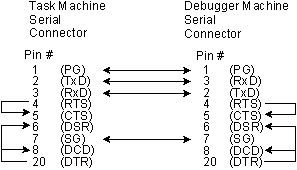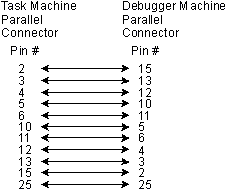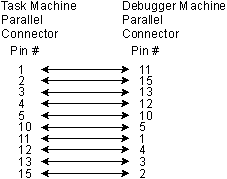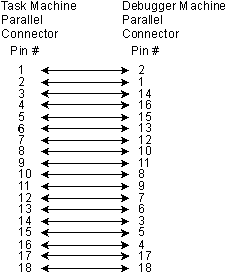Appendix: Wiring for Remote Debugging
This appendix describes both serial and parallel port cable wiring for remote debugging.Serial Port Wiring Considerations
Null-modem cable
If you plan to use the serial port Debug Server serserv, a cable must connect the serial ports of the two computer systems. The following diagram illustrates the wiring between the two serial ports. If your computer systems have more than one serial port, any serial port may be used.

Note that the wiring is symmetrical (that is, either end of the cable can be plugged into either PC). This particular arrangement of the wiring is sometimes called a null modem (since pins 2 and 3 are crossed and no modem is involved).
Parallel Port Wiring Considerations
If you plan to use the parallel port Debug Server parserv or parservw, a cable must connect the parallel ports of the two computer systems.
Three cabling methods are supported: the LapLink cable, the Flying Dutchman cable, and WATCOM's own design. There are two advantages to using the LapLink or Flying Dutchman cable:
- They are commercially available (you may already own one).
- They may work with more PC-compatibles than WATCOM's cable. WATCOM's cabling requires 8 bi-directional data lines in the parallel port, and some PC-compatibles don't support this.
The disadvantage with the LapLink and Flying Dutchman cables is that they're slower than WATCOM's cable, since only 4 bits are transmitted in parallel versus 8 bits for WATCOM's. Thus WATCOM's cable is faster, but it has to be custom-made.
 |
Although the wiring is different for all three cables, WATCOM's parallel communications software can determine which one is in use. |
Laplink cable
The LapLink cable is available from:
Travelling Software, Inc.18702 North Creek Parkway
Bothell, Washington,
U.S.A. 98011
Telephone: (206) 483-8088
The following diagram illustrates the LapLink cable wiring between the two parallel ports.

Flying Dutchman cable
The Flying Dutchman cable is available from:
Cyco,Adm. Banckertweg 2a,
2315 SR Leiden,
The Netherlands.
The following diagram illustrates the Flying Dutchman cable wiring between the two parallel ports.

For the IBM PC and PS/2, the connectors are standard ``male'' DB-25 connectors. Note that, in all cases, the wiring is symmetrical (that is, either end of the cable can be plugged into either PC).
Watcom's cable
The following diagram illustrates WATCOM's cable wiring between the two parallel ports.
